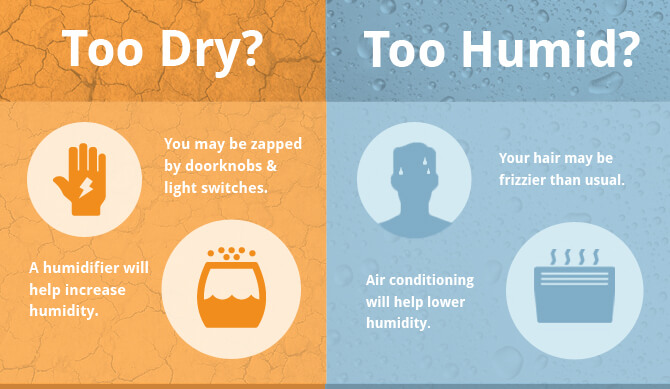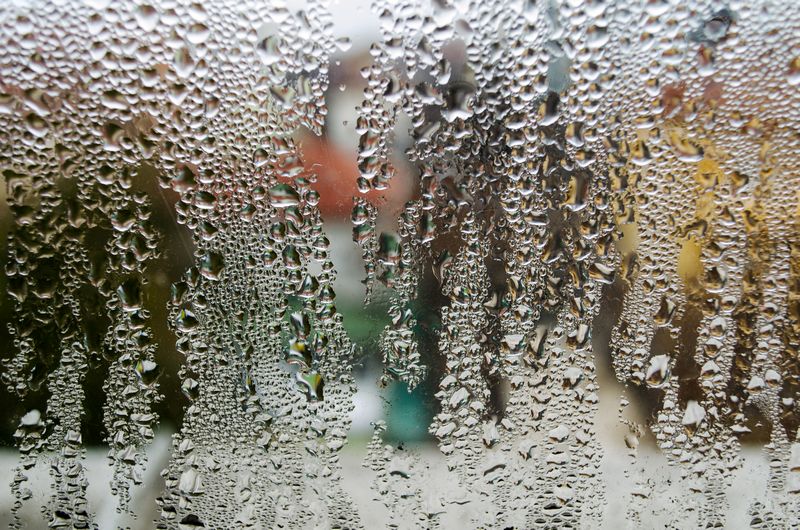
Humidity & Dry Air: How They Influence Indoor Comfort Levels
Indoor comfort is influenced by various factors, and one important factor is the quality of the air we breathe. The humidity levels and the presence of dry air in our homes and offices can greatly affect our overall comfort.
Humidity refers to the amount of moisture present in the air, and it plays a crucial role in creating a comfortable indoor environment. High humidity levels can make the air feel heavy and sticky, while low humidity levels can lead to dry air. Both extremes can have negative effects on our well-being.
Dry air can cause discomfort, especially during the winter months when the air tends to be drier. It can lead to dry skin, chapped lips, and irritated nasal passages. Additionally, dry air can worsen respiratory conditions, such as asthma and allergies, making it harder to breathe.
On the other hand, high humidity levels can promote the growth of mold and mildew, which can have adverse health effects. It can also contribute to a feeling of stickiness and discomfort, and make it harder for our bodies to cool down through natural perspiration.
Therefore, it is important to maintain optimal humidity levels indoors to ensure comfort and a healthy living environment. This can be achieved through the use of humidifiers and dehumidifiers, depending on the specific needs of each space. By understanding the impact of humidity and dry air on indoor comfort levels, we can take proactive steps to create a more pleasant and healthier atmosphere in our homes and workplaces.
The Importance of Indoor Comfort
Indoor comfort is a crucial factor that can greatly impact our overall well-being and quality of life. The dryness or humidity of the air indoors plays a significant role in determining the comfort levels we experience.
Dry air can have detrimental effects on our health and comfort. It can cause dry skin, dry eyes, and throat irritation. Additionally, dry air can worsen respiratory conditions, such as asthma and allergies, making it harder to breathe and leading to discomfort.
On the other hand, excessive humidity levels can also be problematic. High humidity can create a damp and stuffy environment, promoting the growth of mold, bacteria, and dust mites. This can lead to respiratory issues, allergies, and other health problems.
By maintaining optimal indoor humidity levels and avoiding excessively dry or humid conditions, we can ensure a comfortable and healthy indoor environment. Properly regulating the moisture levels in the air can help prevent dryness, reduce allergies and respiratory problems, and promote overall well-being.
To achieve indoor comfort, it is important to monitor and control the humidity levels in your space. Using a humidifier or dehumidifier can help adjust the moisture levels to the desired range. Additionally, proper ventilation and air circulation can also contribute to maintaining comfortable indoor conditions.
In conclusion, indoor comfort is crucial for our overall well-being. The dryness or humidity of the air indoors has a significant influence on our comfort levels and can impact our health. By ensuring proper humidity levels and maintaining a balanced indoor environment, we can create a more comfortable and healthier living space.
Effects of Humidity on Indoor Comfort
Humidity levels in the air have a significant influence on indoor comfort. Both high humidity and dry air can cause discomfort and affect the overall quality of the indoor environment.
High humidity levels can make the air feel heavy and damp, leading to a sense of stickiness and discomfort. This can be particularly problematic in warmer climates, where high humidity can make the air feel even hotter. In addition to the discomfort, high humidity can promote the growth of mold and mildew, which can have negative effects on both the indoor air quality and the health of the occupants.
On the other hand, dry air can also cause discomfort. Low humidity levels can lead to dry skin, irritated eyes, and respiratory problems. Dry air can also aggravate existing health conditions, such as asthma and allergies. In addition, dry air can cause static electricity, which can be annoying and even damaging to electronic devices.
Maintaining optimal humidity levels in indoor spaces is crucial for ensuring comfort and well-being. The ideal range for indoor humidity levels is around 30-50%. This range strikes a balance between avoiding the negative effects of both high humidity and dry air.
| High humidity | Discomfort, stickiness, promotes mold and mildew growth |
| Dry air | Dry skin, irritated eyes, respiratory problems, aggravates existing health conditions, static electricity |
| Ideal humidity range | Around 30-50% |
Effects of Dry Air on Indoor Comfort
Indoor comfort levels are greatly influenced by the humidity levels in the environment. Dry air, with low humidity levels, can have several negative effects on indoor comfort.
One of the most noticeable effects of dry air is the discomfort it can cause on our skin and respiratory system. When the air is dry, it tends to draw moisture away from our skin, leaving it feeling dry and itchy. Dry air can also irritate our respiratory system, leading to symptoms such as dry throat, coughing, and congestion.
In addition to the physical discomfort, dry air can also impact our overall well-being and mental state. When the air is dry, it can affect our sleep quality, as it can cause dryness and discomfort in our nasal passages, leading to difficulty breathing and disrupted sleep. Dry air can also contribute to feelings of fatigue, as it can dehydrate the body and make us feel more tired and sluggish.
Furthermore, dry air can also have negative effects on our indoor environment. It can cause static electricity buildup, leading to unpleasant shocks and damage to electronic devices. Dry air can also cause materials in our home, such as wood furniture and flooring, to shrink and crack, reducing their lifespan and aesthetic appeal.
| – Discomfort on the skin and respiratory system |
| – Impact on sleep quality and overall well-being |
| – Static electricity buildup and damage to electronics |
| – Damage to materials in the home |
The Role of Humidity in Temperature Perception
The level of humidity in the air has a significant influence on our perception of temperature indoors. Humidity refers to the amount of moisture or water vapor present in the air. When the air is humid, it means that there is a high level of moisture in the atmosphere. Conversely, when the air is dry, it means that there is a low level of moisture in the atmosphere.
Humidity can have both positive and negative effects on our comfort levels indoors. When the humidity is too high, it can make us feel hotter than the actual temperature. This is because high humidity prevents our bodies from effectively evaporating sweat, which is one of the main ways our bodies cool down. As a result, we may feel sticky, sweaty, and generally uncomfortable.
Conversely, when the humidity is too low and the air is dry, it can make us feel colder than the actual temperature. This is because dry air can cause moisture on our skin to evaporate more quickly, which can make us feel cooler. Additionally, dry air can also lead to dry skin, dry throat, and even respiratory problems for some individuals.
Overall, maintaining an optimal level of humidity in indoor spaces is important for ensuring our comfort and well-being. The ideal humidity level for most people is generally considered to be between 40% to 60%. By controlling humidity levels, we can create a more comfortable and pleasant environment to live and work in.
How Humidity Affects Allergies and Respiratory Health
Allergies and respiratory health are greatly influenced by the levels of humidity in the air. Indoor air humidity plays a significant role in determining the comfort level of individuals, especially those suffering from allergies or respiratory issues.
Low humidity levels can lead to dry air, which can irritate the respiratory system and worsen symptoms for those with allergies or respiratory conditions. Dry air can cause dry and itchy nasal passages, throat irritation, and dry skin, making individuals more susceptible to allergens and respiratory irritants.
On the other hand, high humidity levels can create an environment that promotes the growth of mold, dust mites, and other allergens. These allergens can trigger allergic reactions and respiratory problems for sensitive individuals. The moisture in the air also increases the stickiness of allergens, making it easier for them to attach to surfaces and remain in the air for longer periods.
Additionally, high humidity levels can contribute to the development of indoor air pollutants, such as volatile organic compounds (VOCs), which can further aggravate allergies and respiratory conditions. These pollutants can be emitted from various sources, including cleaning products, paints, and furniture.
To maintain optimal indoor air quality and comfort levels, it is important to monitor and control humidity levels. The ideal humidity range for indoor environments is typically between 40% and 60%. Using dehumidifiers or humidifiers can help regulate humidity levels and create a more comfortable and healthier indoor environment for individuals with allergies or respiratory health concerns.
In conclusion, humidity levels in indoor air can significantly impact allergies and respiratory health. Both low and high humidity levels can worsen symptoms and increase the risk of exposure to allergens and respiratory irritants. It is important to maintain balanced humidity levels to ensure optimal comfort and minimize health risks.
The Relationship Between Humidity and Mold Growth
Humidity levels have a significant influence on indoor comfort and can also affect the growth of mold. High humidity levels create an ideal environment for mold to thrive, while low humidity levels can help inhibit mold growth.
Mold is a type of fungus that can grow in areas with excess moisture. It reproduces through the release of spores, which can travel through the air and settle on surfaces. Mold spores are present in almost all indoor environments, but they require the right conditions to grow. One of the key factors that contribute to mold growth is humidity.
When indoor humidity levels are high, typically above 60%, the excess moisture in the air provides the perfect breeding ground for mold. Areas of the home that are commonly affected by high humidity include bathrooms, basements, and kitchens. Mold can appear as black spots or patches on walls, ceilings, and other surfaces.
On the other hand, dry air with low humidity levels can help prevent mold growth. When humidity levels drop below 40%, the lack of moisture makes it difficult for mold spores to survive and reproduce. This is why maintaining proper humidity levels is crucial in preventing mold infestations.
To control indoor humidity levels and reduce the risk of mold growth, it is important to properly ventilate areas prone to moisture, such as bathrooms and kitchens. Using exhaust fans and opening windows can help remove excess moisture from the air. Additionally, using dehumidifiers can help lower humidity levels in humid climates or during the summer months.
In conclusion, humidity levels have a direct impact on mold growth. High humidity creates a favorable environment for mold to thrive, while lower humidity levels can help inhibit its growth. By maintaining proper humidity levels and controlling moisture in the indoor environment, it is possible to minimize the risk of mold and improve overall indoor comfort.
Humidity’s Impact on Furniture and Wood
Humidity levels can have a significant impact on the condition and longevity of furniture and wood in your indoor space. Both high and low humidity can influence the comfort and overall quality of your air, as well as the well-being of your furniture and wooden items.
High humidity levels can cause wooden furniture to swell and warp. This can lead to cracks and structural damage, affecting the appearance and durability of your furniture. Excess moisture in the air can also promote the growth of mold and mildew, which can further damage your wooden items and create an unhealthy indoor environment.
On the other hand, dry air can cause wood to shrink and become brittle. This can result in loose joints, gaps between wooden components, and overall instability of your furniture and wooden structures. Dry air can also cause wood to lose its natural moisture content, leading to a dull and faded appearance.
To maintain the condition of your furniture and wooden items, it is important to keep humidity levels within an optimal range. Ideally, indoor humidity should be between 40% and 50%. This range ensures a balance between preventing excess moisture and avoiding excessive drying of the wood.
Using a humidifier in dry environments or a dehumidifier in humid environments can help regulate humidity levels and protect your furniture and wood. Additionally, regular dusting, polishing, and conditioning can also help maintain the quality and appearance of your wooden items.
By understanding the influence of humidity on furniture and wood, you can take proactive measures to ensure their longevity and keep your indoor space comfortable and aesthetically pleasing.
How Dry Air Affects Skin and Respiratory Health
Dry air can have a significant influence on our overall health, particularly on our skin and respiratory systems. When the humidity levels indoors are low, the air tends to become dry, leading to various discomforts and potential health issues.
One of the primary impacts of dry air is its effect on the skin. Low humidity levels can cause the skin to become dry, itchy, and irritated. The lack of moisture in the air can strip away natural oils from the skin, leaving it feeling tight and dehydrated. This can lead to skin conditions such as eczema, psoriasis, and dry patches. Additionally, dry air can worsen existing skin conditions and delay the healing process.
Dry air also affects respiratory health. When the air lacks humidity, it can dry out the mucus membranes in the respiratory tract, including the nose and throat. This can lead to symptoms such as a dry, sore throat, nasal congestion, and increased susceptibility to respiratory infections. Inadequate humidity levels indoors can also aggravate respiratory conditions such as asthma and allergies.
To maintain optimal indoor comfort and protect our skin and respiratory health, it is essential to ensure sufficient humidity levels. Using devices such as humidifiers can help add moisture to the air, alleviating the negative effects of dry air. Additionally, staying hydrated by drinking plenty of water and using moisturizers can help keep our skin hydrated and healthy.
The Impact of Dry Air on Plants and Indoor Greenery
Indoor plants not only add beauty to our living spaces, but they also have a positive influence on our well-being. However, when the air indoors becomes excessively dry, it can have a detrimental effect on the health and appearance of our precious indoor greenery.
Dry air, particularly when combined with low humidity levels, can result in a variety of problems for plants. One of the main issues is that it increases the rate of evaporation from the leaves, causing them to lose moisture more quickly. This can lead to dehydration and wilting, making the plants look dull and unhealthy.
In addition to affecting the appearance of plants, dry air can also hinder their growth and development. When the air lacks sufficient moisture, it becomes difficult for plants to absorb water and nutrients through their root systems. This can stunt their growth and make them more vulnerable to diseases and pests.
Furthermore, dry air can interfere with the plants’ ability to perform photosynthesis effectively. Photosynthesis is the process by which plants convert sunlight into energy, and it requires a certain level of moisture in the air for optimal performance. When the air is too dry, photosynthesis becomes less efficient, leading to slower growth and weaker plants.
To combat the negative effects of dry air on indoor plants, it is important to maintain a suitable level of humidity in the surrounding environment. This can be achieved by using a humidifier or placing a tray filled with water near the plants. Regularly misting the leaves with water can also help to increase humidity and provide some relief to the plants.

| 1. Dehydration and wilting |
| 2. Stunted growth and vulnerability to diseases and pests |
| 3. Reduced efficiency of photosynthesis |
In conclusion, the comfort levels of indoor plants are heavily influenced by the humidity and moisture levels in the air. Dry air can have a negative impact on their health, growth, and overall appearance. By taking measures to increase humidity and provide adequate moisture, we can ensure that our indoor greenery thrives and enhances the beauty of our living spaces.
Balancing Humidity and Dryness for Optimal Comfort
In indoor environments, the levels of humidity and dryness in the air can greatly influence our comfort and overall well-being. Maintaining a balanced humidity level is key to creating an optimal indoor environment.
When the air is too humid, it can feel sticky and uncomfortable. High humidity levels can also lead to mold and mildew growth, which can negatively impact indoor air quality and cause respiratory issues. On the other hand, dry air can result in dry skin, irritated eyes, and respiratory problems. Both extremes can be detrimental to our comfort.
It is important to find a balance between humidity and dryness to achieve optimal comfort. Monitoring and controlling humidity levels in indoor spaces can help create a comfortable environment for everyone. Humidity control options include using humidifiers in dry areas or dehumidifiers in humid areas.
Additionally, proper ventilation is essential in maintaining a healthy indoor environment. Fresh air exchange can help regulate the humidity levels and prevent the accumulation of moisture or dryness in the air.
Furthermore, it is crucial to understand that different seasons and climates can affect indoor humidity levels. During colder months, humidity tends to drop due to heating systems, while in warmer months, humidity levels can increase. Adjusting the humidity control accordingly can ensure a comfortable indoor experience throughout the year.
In conclusion, finding the right balance between humidity and dryness is essential for optimal comfort levels in indoor environments. Monitoring and controlling humidity levels, ensuring proper ventilation, and adapting to seasonal changes are all important factors to consider when striving for a comfortable and healthy indoor environment.
Strategies for Controlling Humidity Levels
Humidity levels in indoor air can greatly influence comfort and overall indoor air quality. When the air is too dry, it can lead to discomfort, dry skin, irritation of the respiratory system, and even increased susceptibility to illnesses. On the other hand, excessive humidity can promote the growth of mold and other allergens, and create a damp environment that is conducive to the spread of bacteria and viruses.
Controlling humidity levels is essential to creating a comfortable and healthy indoor environment. Here are some strategies that can help:
1. Use a humidifier or dehumidifier: Depending on the current humidity level, you may need to add moisture to the air using a humidifier or remove excess moisture using a dehumidifier. These devices can help maintain a desirable humidity range and prevent dryness or excessive dampness.
2. Proper ventilation: Good ventilation is crucial in controlling indoor humidity. Opening windows and using fans can help circulate the air and reduce humidity levels. Additionally, using exhaust fans in bathrooms and kitchens can help remove excess moisture generated from activities like showering and cooking.
3. Regular maintenance of HVAC systems: Heating, ventilation, and air conditioning (HVAC) systems play a significant role in controlling humidity levels. Regularly maintaining and cleaning these systems can ensure they are functioning optimally and effectively managing indoor humidity.
4. Use moisture-absorbing materials: Incorporating moisture-absorbing materials such as desiccants or silica gel can help control humidity levels in specific areas. These materials attract and hold moisture, reducing the overall humidity in the surrounding air.
5. Monitor and control moisture sources: Identifying and managing moisture sources within the indoor environment is crucial. Leaks, condensation, and damp areas should be addressed promptly to prevent the accumulation of excess moisture and the growth of mold and mildew.
In conclusion, understanding and controlling humidity levels is essential for maintaining a comfortable and healthy indoor environment. By implementing these strategies, individuals can create a balanced indoor atmosphere and minimize the impact of dry or excessively humid air on their overall well-being.
Strategies for Combating Dry Air
Indoor humidity levels have a significant influence on our comfort and well-being. Dry air can lead to various discomforts, such as dry skin, irritated eyes, and respiratory issues. Fortunately, there are several strategies that can help combat dry air and create a more comfortable indoor environment.
1. Use a humidifier: Adding moisture to the air with a humidifier is one of the most effective ways to combat dry air. Humidifiers release water vapor into the air, increasing the humidity levels and improving comfort. There are different types of humidifiers available, including cool mist and warm mist options, so choose the one that suits your preferences and needs.
2. Keep indoor plants: Plants naturally release moisture through a process called transpiration. Having a few indoor plants can help increase humidity levels and add moisture to the air. Spider plants, Boston ferns, and peace lilies are some of the popular options for improving indoor humidity.
3. Avoid overusing heating systems: Heating systems, such as central heating or space heaters, can contribute to dry air by reducing humidity levels. Try to avoid running these systems excessively, especially during the winter months, as they can remove moisture from the air. Consider using a humidifier alongside your heating system to maintain comfortable humidity levels.
4. Ventilate your home: Proper ventilation is crucial for maintaining good indoor air quality. Opening windows and doors periodically can help bring in fresh outdoor air, which tends to have higher humidity levels. However, be cautious about outdoor conditions – if it is cold or extremely dry outside, it may worsen the indoor humidity levels. Use window screens or air filters to prevent the entry of dust or pollutants.
5. Seal air leaks: Unwanted air leaks can let dry air from outdoors enter your home, reducing indoor humidity levels. Inspect your doors, windows, and other potential areas for gaps or cracks that might cause drafts. Sealing these leaks with weatherstripping or caulking can help retain moisture indoors and decrease the impact of dry air.
6. Use water-based appliances: Appliances that use water, such as a steam iron or a kettle, release moisture into the air while in use. Utilizing these appliances can help increase humidity levels temporarily. Just make sure to follow safety guidelines and use them appropriately.
Dry air can be uncomfortable, but by implementing these strategies, you can combat its effects and create a more pleasant indoor environment with optimal humidity levels.
The Role of Air Conditioning and Heating Systems
Air conditioning and heating systems play a crucial role in maintaining the optimal indoor comfort levels, especially in environments where humidity and dry air can have a significant influence.
During hot and humid weather, air conditioning systems are essential for cooling down the indoor environment. These systems work by removing excess heat from the air and reducing the humidity levels. By doing so, they create a more comfortable atmosphere and help prevent issues such as heat exhaustion and dehydration.
On the other hand, during colder months when the air tends to be dry, heating systems come into play. These systems not only warm up the indoor space but also help to add moisture to the air, combating the dryness that can cause discomfort, dry skin, and respiratory problems.
Both air conditioning and heating systems use various mechanisms to regulate the temperature and humidity levels within a building. They can be equipped with humidifiers or dehumidifiers, which adjust the humidity to the desired level. Additionally, advanced systems can also incorporate sensors that monitor the humidity and automatically adjust the settings accordingly.
By maintaining a balanced and comfortable indoor environment, air conditioning and heating systems significantly contribute to the overall well-being and productivity of individuals. When the indoor comfort levels are compromised, it can lead to discomfort, decreased focus, and even health issues.
It is essential to properly maintain and service these systems regularly to ensure their efficient functioning and longevity. By doing so, we can rely on them to create a comfortable, healthy, and inviting environment, no matter the season or weather conditions outside.
The Importance of Proper Ventilation
Proper ventilation plays a crucial role in maintaining optimal indoor comfort levels. It is not only essential for ensuring good air quality but also for managing humidity levels and preventing the negative effects of dry air.
Humidity, which refers to the amount of moisture present in the air, can greatly impact indoor comfort. High humidity levels can lead to a sticky and uncomfortable environment, promoting the growth of mold and mildew, and causing allergies and respiratory issues. On the other hand, low humidity levels, such as those experienced in dry air, can result in dry skin, irritated nasal passages, and an overall feeling of discomfort.
Having proper ventilation in place helps to regulate humidity levels by allowing the exchange of indoor and outdoor air. Ventilation systems such as exhaust fans, air conditioners, and windows facilitate the removal of excess moisture from indoor spaces, thus reducing humidity levels. At the same time, proper ventilation also ensures a continuous supply of fresh air, replenishing oxygen and preventing the buildup of stagnant air, odors, and pollutants. This, in turn, enhances indoor air quality and promotes a healthier and more comfortable living environment.
Moreover, proper ventilation can also help regulate temperature levels. In warm and humid conditions, ventilation allows for the removal of hot air, cooling the indoor space and creating a more comfortable atmosphere. In contrast, during colder months, ventilation helps to prevent the buildup of cold and stagnant air, improving overall comfort levels.
In conclusion, ensuring proper ventilation is crucial for maintaining optimal indoor comfort levels. By managing humidity, improving air quality, and regulating temperature, ventilation plays a significant role in promoting a healthy and comfortable living environment.
The Benefits of Indoor Air Quality Monitoring
Monitoring indoor air quality is essential for maintaining a healthy and comfortable living environment. Dry air, humidity, and other factors can greatly influence the comfort levels indoors. With proper monitoring, you can identify and address issues that may be affecting the quality of the air you breathe.
| Improved Comfort | Indoor air quality monitoring allows you to assess and adjust the humidity levels to achieve optimal comfort. Dry air can cause skin irritation, itchy eyes, and respiratory problems. Monitoring the moisture content helps bring the indoor humidity to an ideal level, enhancing overall comfort. |
| Healthier Environment | Poor indoor air quality can lead to various health issues, including allergies, asthma, and other respiratory problems. By monitoring air quality, you can identify potential pollutants or allergens and take appropriate measures to reduce their presence. This promotes a healthier environment, especially for individuals with sensitivities or allergies. |
| Energy Efficiency | Monitoring indoor air quality can help identify areas where energy efficiency improvements can be made. By optimizing the humidity levels and addressing air leaks or poor ventilation, you can reduce energy waste and lower utility bills. |
| Productivity and Focus | Poor indoor air quality can impact cognitive function, concentration, and productivity. Monitoring air quality ensures a healthier workspace, helping to improve focus and performance. Maintaining proper humidity levels can also prevent discomfort and distractions caused by dry air. |
| Early Detection of Issues | Regular monitoring allows for early detection of potential problems, such as mold growth, excessive dust, or unusual odors. By identifying these issues early on, you can take prompt action to prevent further damage and maintain a safe and comfortable living or working environment. |
Indoor air quality monitoring is an essential tool for maintaining a healthy and comfortable indoor environment. By monitoring humidity levels and identifying potential pollutants or allergens, you can ensure optimal comfort, promote better health, improve energy efficiency, enhance productivity, and detect issues early on. Investing in indoor air quality monitoring is a valuable step towards creating a safe and enjoyable living or working space.
Q&A:
What is the ideal humidity level for indoor comfort?
The ideal humidity level for indoor comfort is typically between 40% and 60%. This range helps to maintain a balance between too much moisture, which can lead to discomfort and mold growth, and too little moisture, which can cause dry skin and respiratory issues.
How does high humidity affect indoor comfort?
High humidity can make indoor spaces feel sticky and uncomfortable. It can also contribute to mold and mildew growth, which can lead to respiratory issues and allergies. Additionally, high humidity can make it harder for the body to cool itself through sweating, making it feel hotter than it actually is.
How does dry air affect indoor comfort?
Dry air can cause a variety of discomforts, including dry skin, dry eyes, and irritated respiratory passages. It can also lead to static electricity buildup, which can be annoying and potentially damaging to electronic devices. Dry air can make the indoor environment feel cooler than it actually is, causing people to turn up the heat and use more energy.
What are some solutions for maintaining proper humidity levels indoors?
There are several solutions for maintaining proper humidity levels indoors. Using a humidifier during dry periods can add moisture to the air. Opening windows and allowing fresh air in can also help regulate humidity levels. Ensuring proper ventilation in bathrooms and kitchens can help remove excess moisture. Additionally, using a dehumidifier in humid climates or during certain seasons can help remove excess moisture from the air.






